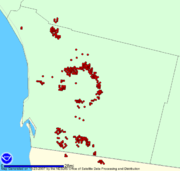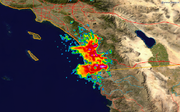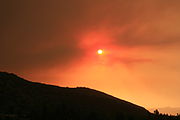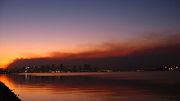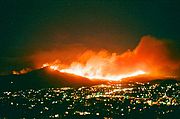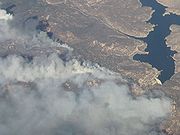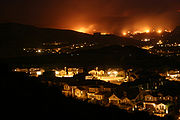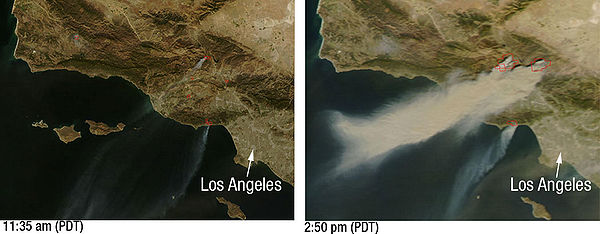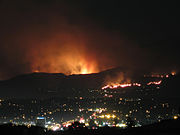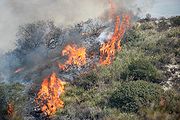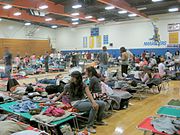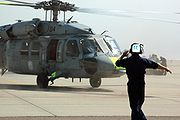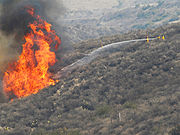
October 2007 California wildfires
Did you know...
Arranging a Wikipedia selection for schools in the developing world without internet was an initiative by SOS Children. Do you want to know about sponsoring? See www.sponsorachild.org.uk
| Fall 2007 California Wildfires | |
|---|---|
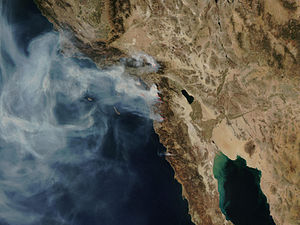 NASA satellite photo (provided by NSPO, Taiwan National Space Organization) from October 23, 2007, showing the active fire zones and smoke plumes. |
|
| Location | Southern California |
| Date | October 20, 2007 – November 9, 2007 |
| Burned area | 500,000 acres (2,000 km2) |
| Ignition source | Various |
| Land use | Mixed, residential and wildlands |
| Fatalities | 14 |
| Injuries | At least 70 |
The October 2007 California wildfires were a series of wildfires that began burning across Southern California on October 20. At least 1,500 homes were destroyed and over 500,000 acres (2,000 km², or about 770 mi²) of land burned from Santa Barbara County to the U.S.–Mexico border. Nine people died as a direct result of the fires; 85 others were injured, including at least 61 firefighters. The raging fire was visible from space.
California Governor Arnold Schwarzenegger declared a state of emergency in seven California counties where fires were burning. President George W. Bush concurred, and ordered federal aid to supplement state and local response efforts. Over 6,000 firefighters worked to fight the blazes; they were aided by units of the United States Armed Forces, United States National Guard, almost 3,000 prisoners convicted of non-violent crimes, and 60 firefighters from the Mexican cities of Tijuana and Tecate. The fires forced approximately 1,000,000 people to evacuate their homes, the largest evacuation in California's history.
Major contributing factors to the extreme fire conditions were drought in Southern California, hot weather, and the strong Santa Ana winds with gusts reaching 85 mph (140 km/h). California's "fire season," which traditionally runs from June to October, has become a year-round threat due to a mixture of perennial drought and the increasing number of homes built in canyons and on hillsides surrounded by brush and forest.
The fires had numerous sources. Several were triggered by power lines damaged by the high winds. One fire started when a semi-truck overturned. Another was suspected as having been deliberately caused; the suspect was shot and killed in flight by state authorities. A 10-year-old boy admitted that he accidentally started the Buckweed Fire playing with matches. Causes of the remaining fires remain under investigation. The last fire was fully contained on November 9, 2007, 19 days after the series of fires started.
Counties
San Diego County
Of all the fires, the two biggest were located in San Diego County. The largest, the Witch (Creek) Fire, burned areas north and northeast of San Diego. The second largest, the Harris Fire, burned northwest from the U.S–Mexico border towards San Diego. Officials feared the fires could become even more destructive than the 2003 Cedar Fire that burned 280,278 acres (1,134.2 km2), 2,820 buildings (including 2,232 homes) and killed 15 people (including one firefighter) before being contained on November 3, 2003. Though individually the fires did not surpass the Cedar Fire, if combined as one, they did.
Residents were subjected to a mix of mandatory and voluntary evacuations, depending on the projected path of a fire. Hundreds of thousands of residents were notified of evacuations via a computerized Reverse 911 phone call system. While this alert system was mostly effective, many residents in Rancho Bernardo received the calls after they had been driven from their homes. On the other hand, in Carmel Valley, only the northern half was officially evacuated, but a computer error mistakenly sent Reverse 911 calls to the southern half as well. Law enforcement officers also notified residents by driving through evacuation areas. On October 24, 2007, San Diego County Sheriff Bill Kolender stated that the number of people evacuated in San Diego county had exceeded the number evacuated from New Orleans, Louisiana during Hurricane Katrina.
Two days into the fires, approximately 500,000 people from at least 346,000 homes were under mandatory orders to evacuate, the largest evacuation in the region's history. Evacuation sites included Qualcomm Stadium, as well as many schools, civic centers, and churches throughout the area. The American Red Cross managed the evacuation centers.
Officials estimated that 12,000 gathered at Qualcomm. Volunteers provided food, blankets, water, internet services, children's toys, massages, and a live rock band performance for those at the stadium. Nearly all public schools and universities in the San Diego area were closed. Many businesses closed as well. To ensure clear roads for emergency vehicles, San Diego mayor Jerry Sanders asked residents to stay home and inside.
By October 23, some evacuations were lifted, allowing about 50,000 residents from the cities of Del Mar, Chula Vista, and Poway, and the San Diego neighborhoods of Del Mar Heights and Scripps Ranch to return home. However, the fires continued and damage was severe. The four major fires across San Diego County burned nearly 300,000 acres (1,200 km2) and destroyed or damaged 1,350 homes and 100 businesses since October 21, 2007.
Many major roads were closed as a result of fires and smoke. On October 22, the California Highway Patrol closed Interstate 15 in both directions between State Routes 78 and 56. On October 24, 2007 the Horno Fire forced the closure of Interstate 5 as well as the Amtrak Surfliner service between Oceanside and San Clemente. Traffic from Interstate 5 was diverted to Interstate 15, which had reopened.
Officials from the San Diego Wild Animal Park said that its more than 3,500 animals were safe staying in their enclosures where they were protected by the park's fire break and irrigated areas. If the weather conditions worsened, the animals could retreat to their watering holes. However, many critically endangered animals such as the California condor were moved to the park's veterinary hospital, which is fire-resistant and fully equipped with sprinklers. Park spokesperson Yadira Galindo said that the animals were "alert but not showing any concerned behaviour."
Fire data was provided by the CAL FIRE and independent news media. As of November 2007: the following fires burned in San Diego County:
| Fire name | Date / time started | Area burned | Structures destroyed | Injuries | Containment |
|---|---|---|---|---|---|
| Witch (Creek) | October 21 at 11:00 a.m. | 197,990 acres (801 km2) | 1040 homes 414 outbuildings 239 vehicles 70 homes damaged 25 outbuildings damaged |
2 deaths 39 firefighters 2 civilians |
100% |
| Harris | October 21 at 9:30 a.m. | 90,440 acres (366 km2) | 206 homes 252 outbuildings 253 structures damaged |
5 deaths 34 firefighters 21 civilians |
100% |
| Poomacha (Palomar Mountain/Valley Centre) | October 23 at 3:13 a.m. | 50,176 acres (203.06 km2) | 143 homes 77 outbuildings |
21 firefighters | 100% |
| Horno/Ammo | October 24 | 21,084 acres (85.32 km2) | 6 firefighters | 100% | |
| Rice | October 22 at 4:16 a.m. | 9,000 acres (36.4 km2) | 206 homes 2 commercial properties 40 outbuildings |
5 firefighters | 100% |
| McCoy | October 21 | 300 acres (1.21 km2) | 1 residence 1 outbuilding |
100% | |
| Coronado Hills | October 22 at 1:50 a.m. | 250 acres (1.01 km2) | 2 outbuildings | 100% on Oct. 22 | |
| Wilcox | October 23 | 100 acres (0.40 km2) | 100% |
Witch Creek Fire
The Witch Creek Fire was the largest of the October 2007 wildfires and surpassed the 1970 Laguna Fire as the second-largest fire in California History. Hundreds of thousands of residents were informed of evacuations through the Reverse 911 system. This evacuation came almost four years to the day after the Cedar Fire of 2003.
The fire started in Witch Creek Canyon near Santa Ysabel and quickly spread to Ramona, Rancho Bernardo, Poway and Escondido. Locals in the San Pasqual Valley area reported wind gusts of over 100 mph (160 km/h). From there the fire jumped over Interstate 15 and continued west, causing significant damage in Lake Hodges, Del Dios and Rancho Santa Fe.
Strong Santa Ana winds pushed the fires west towards the coast. San Diego County Sheriff William B. Kolendar stated that the Witch Creek Fire could be "well in excess of the Cedar Fire of 2003". While many coastal communities were evacuated as the fire moved west, the shifting winds prevented it from directly threatening those areas.
All residents located south of Del Dios Highway, north of State Route 56, west of Interstate 15, and east of Interstate 5 were ordered to evacuate. By 9:30 p.m. on October 22, a dispatch from the city of Del Mar's web site stated "For your safety, we are strongly advising that all Del Mar residents evacuate." Evacuations were also ordered for Scripps Ranch neighbourhood, specifically "Everything south of Scripps Poway Parkway, north of MCAS Miramar, east of Interstate 15, and west of Highway 67". The Mesa Grande Indian Reservation was evacuated due to the Witch Fire. Residents of the Barona Indian Reservation were advised to leave, though the evacuation was not mandatory. The casino on the reservation was closed. At approximately 01:00 on 23 October, fire broke out near Wildcat Canyon to the south of Barona, where many houses were destroyed and lives lost in the Cedar Fire. Residents of Wildcat Canyon and Muth Valley were ordered to evacuate, and the road was closed. The evacuations of Del Mar, Chula Vista, Poway, Del Mar Heights and Scripps Ranch were lifted for many residents on Tuesday October 23 in the late afternoon. At 9:50 p.m. PDT October 23, 2007, the town of Julian, California was ordered to evacuate. Due to the fires, there was no power or phone service in the town.
Evacuation sites included Qualcomm Stadium, Escondido High School, Mission Hills High School, Poway High School, Mira Mesa Senior High School, and the Del Mar Fairgrounds.
Many major roads were also closed as a result of fires and smoke. On October 22, the California Highway Patrol closed Interstate 15 in both directions between State Routes 78 and 56. On October 24, 2007 the Horno Fire forced the closure of Interstate 5 as well as the Amtrak Surfliner service between Oceanside and San Clemente. Traffic from Interstate 5 was being diverted to Interstate 15, which had reopened. 1,841 firefighters were assigned to the fire.
Around 4pm on October 21, three hours after the Witch Creek Fire started, the following photo and video were taken by an amateur radio operator from a 4,200-foot (1,300 m) overlook in Pine Hills, about three miles (5 km) east of the fire's origin point. The fire can be seen moving rapidly from Witch Creek towards the town of Ramona, where nearly 40,000 people were evacuated.
Harris Fire
The Harris Fire burned in a northwest direction from its starting point at Harris Ranch Road in the town of Potrero, in the far south of San Diego County, a few miles north of Tecate, Mexico. On October 23 the fire approached eastern Chula Vista.
Many communities were evacuated, with evacuation centers set up at a nearby high school and community centre.
Thomas James Varshock, 52, of Potrero, died on his property during the Harris Fire on Sunday. His teenage son suffered burn injuries, as did four firefighters of the California Department of Forestry and Fire Protection who attempted to rescue them. The fire may also have caused the deaths of four migrant workers near the U.S.–Mexico border. An estimated 1,210 firefighters battled this fire.
The Harris Fire also affected northern Mexico, near the town of Tecate.
Other fires
- Marine Corps Base Camp Pendleton Fires:
- The Wilcox Fire began at Santa Margarita/33 Area behind Marine Corps Air Station Camp Pendleton.
- The Ammo Fire was located near the Las Pulgas/43 Area and Basilone Road.
- The Horno Fire burned 21,084 acres (85 km2), and was located in the Basilone Road and Canyon Road/Las Flores/41 Area.
- The Poomacha Fire (or Mt. Palomar Fire) began as a structure fire on the La Jolla Indian Reservation, then established itself on Palomar Mountain, joined the Witch Fire, and entered the Agua Tibia Wilderness. Because of steep terrain, it continued to burn after all other October 2007 fires were put out, finally reaching full containment November 9, 2007.
- The Rice Canyon Fire started in the early morning of October 22, in the Rice Canyon near Fallbrook. It caused massive evacuations and the closure of Interstate 15.
- The Rice Canyon Fire was caused by downed power lines.
- The Coronado Hills Fire started near San Marcos, and burned south of Cal State San Marcos.
- On October 23, the San Diego Union Tribune reported on the El Capitan Fire: "A small brush fire that burned today around El Capitan Reservoir north of Alpine is out, Cal Fire officials said about 9:30 p.m. Officials said the blaze consumed the vegetation near the reservoir and ran out of fuel."
- The McCoy Fire was located near the U.S. Forest Service on Cuyamaca Mountain. It burned 400 acres (1.6 km2) and destroyed at least one structure in Pine Hills.
Los Angeles and Ventura counties
Fire data has been provided by the CAL FIRE and independent news media. As of October 2007:
| Fire Name | Date / Time Started | Area Burned | Structures Destroyed | Injuries | Containment |
|---|---|---|---|---|---|
| Ranch (Castaic / Piru) | October 20 at 9:42 p.m. | 58,401 acres (236.3 km2) | 1 home 9 outbuildings |
100% | |
| Buckweed | October 21 at 12:55 p.m. | 38,356 acres (155.2 km2) | 63 | 3 civilians 1 firefighter |
100% |
| Canyon | October 21 at 4:50 a.m. | 4,565 acres (18.5 km2) | 22 | 3 | 100% |
| Magic | October 22 at 2:17 p.m. | 2,824 acres (11.4 km2) | 100% | ||
| Meadowridge | October 23 at 12:30 p.m. | 40 acres (0.162 km2) | 100% | ||
| Nightsky | October 21 at 10:35 a.m. | 35 acres (0.1 km2) | 100% | ||
| October | October 22 at 10:40 p.m. | 25 acres (0.1 km2) | At least 3 mobile homes damaged | 100% on October 23 |
- The Buckweed Fire burned north of Santa Clarita in Agua Dulce and the community of Canyon Country, triggering many evacuations. This fire was the result of a child playing with matches.
- The Canyon Fire burned around Malibu, California, specifically in Malibu Canyon. It was the first of the October California wildfires to receive significant attention from the national media. In addition to damaging or destroying 14 homes, the fire destroyed two Malibu landmarks: Castle Kashan and the Presbyterian Church.
- The Magic Fire started near The Old Road at Magic Mountain Parkway, within a half mile of the Six Flags Magic Mountain theme park on the west side of Santa Clarita. Flames came within a few yards of West Ranch High School and a large housing development in Stevenson Ranch, but were pushed away. The fire is believed to have been caused accidentally by welders at a construction site.
- The Meadowridge Fire began near Highway 14 and San Fernando Road in Santa Clarita.
- The October Fire burned a small area in Santa Clarita, destroying several homes in the Canyon Breeze Mobile Home Park.
- The Ranch Fire (or Castaic Fire) burned along the Los Angeles- Ventura county line about 5 miles (8.0 km) north of Santa Clarita, in the Angeles and Los Padres national forests. It surrounded the Ventura County community of Piru and also threatened the communities of Fillmore, Ventura and Ojai. About 500 residences lie in the fire's path. Evacuations were recommended in all of Piru and portions of Fillmore. Angeles National Forest officials implemented a total forest closure on October 23.
- The Nightsky Fire burned a small area south of Moorpark in Ventura County.
Orange County
- The Santiago Fire began shortly before 5:55 p.m. on October 21, 2007 in the foothills north of Irvine and east of the city of Orange in Orange County. The fire was reportedly started in two separate spots (along Santiago Canyon Road, west of Silverado Canyon Road); fire officials have attributed the source of the fire to arson. On October 24, 2007, Governor Arnold Schwarzenegger visited an evacuation centre at El Toro High School. Schools and districts all over Orange County were closed on Friday, October 26, 2007 because of the smoke and bad air quality. A reward of $250,000 was offered for information leading to arrest of the arsonist(s). Fourteen homes and twenty four outbuildings were destroyed. Eight homes and three outbuildings were damaged, and sixteen firefighters were injured. In all, the fire burned 28,445 acres (115.1 km2).
San Bernardino County
Current data on the fires has been provided by the CAL FIRE and independent news media. As of October 30:
| Fire Name | Date / Time Started | Area Burned | Structures Destroyed | Injuries | Containment |
|---|---|---|---|---|---|
| Slide (Running Springs) | October 22 at 8:02 a.m. | 12,789 acres (51.8 km2) | 201 homes 3 outbuildings |
100% | |
| Grass Valley | October 22 at 5:08 a.m. | 1,247 acres (5.0 km2) | 174 homes 2 outbuildings |
100% | |
| Martin | October 23 at 9:00 a.m. | 123 acres (0.5 km2) | 1 home damaged | 1 firefighter | 100% |
| Walker | October 23 | 160 acres (0.6 km2) | 2 firefighters | 100% on Oct. 27 | |
| Cajon (Devore & Glen Helen) | October 22 at 12:15 p.m. | 250 acres (1.0 km2) | 100% | ||
| Little Mountain Fire | October 22 at 3:30 p.m. | 650 acres (2.6 km2) | 100% on October 22 |
- The Slide or Green Valley Lake Fire burned near Green Valley Lake, east of Lake Arrowhead. The Green Valley Lake, Arrowbear, and Running Springs communities were evacuated. 1,359 firefighters were assigned to the fire. The estimated cost is $1.2 million. Water pressure in local systems was lost and conditions were too extreme for fighters to continue efforts in some areas. The fire partially burned "Camp Helendade," owned by the Boy Scouts of America's local council, the California Inland Empire Council. Helendade was originally given to the council in 1960 to replace another camp that had been burned.
- The Grass Valley Fire was located just north of Lake Arrowhead.
- The Martin Fire began near Martin Ranch Road at Meyers Road.
- The Walker Fire burned near Walker Ave in the dairies of Ontario.
- Together, the Devore and Glen Helen Fires (or Cajon Fire) forced the closure of Interstate 15 in the Cajon Pass. One fire was started by an overturned semi-truck.
- The Little Mountain Fire threatened several homes and other structures near Cal State San Bernardino before it was contained. Due to the cumulative effects of the area fires, the University closed for the week of October 23.
Santa Barbara County
- The Sedgewick Fire was the northernmost of the October 2007 California wildfires. It ignited around 6:00 a.m. PDT on October 21, 2007 from a downed power line. The fire burned a total of 710 acres (2.9 km2) near Los Olivos. Approximately 2000 people were affected and 800 homes threatened before the fire was 100% contained around 5:00 p.m. on October 22.
Riverside County
- The Roca Fire was reported around 3:52 p.m. on October 21 in the vicinity of SR 79 at SR 371 in Aguanga. One home was destroyed and one injury was reported. It was 100% contained on October 22, after burning 270 acres (1.1 km2).
- The Rosa Fire, three clustered blazes in the Via Santa Rosa/Rancho California Road area of western Temecula began October 22. It was 100% contained by October 24, after burning 411 acres (1.7 km2). Investigators suspect arson.
- The Wildomar Fire began around 12:30 on October 24 in Wildomar brush, between I-15 and I-215. It was 100% contained within the same day, after burning 20 acres (0.1 km2).
Baja California
Fires also burned in northern parts of the Mexican state of Baja California. The Harris Fire burned near Tecate, and fires burned near Tijuana as well.
More than fifteen thousands hectares were consumed by the wildfires in Baja California. Tijuana, Tecate and Ensenada were the municipalities more affected by the fire. In total there were seven fires caused by Santa Ana winds. The community of Maneadero, in the highlands of Ensenada, was the most affected.
Wind and weather
The fires occurred at the end of a dry summer and were exacerbated by the seasonal Santa Ana winds. The San Diego Union Tribune reported, "Santa Ana winds blowing up to 60 mph (97 km/h) combined with temperatures into the 90s to create in the worst possible fire conditions." At one point swirling winds threatened to bring fire into densely populated urban areas.
Southern California was in the midst of an unusual drought; in Los Angeles, California, with only 3.21 in (82 mm) of precipitation in 2006-2007, it was the driest year on record. The combination of wind, heat, and dryness turned the chaparral into fire fuel. Officials believed that some of the fires generated their own winds, similar to the Oakland Firestorm of 1991. The effects of the smoke were felt as far away as Brentwood, California (in the East Bay, near Stockton), where it impacted local weather. The high-speed Santa Ana winds also rendered the use of dropping water from fire fighting aircraft inefficient; until such winds abate, most payloads of water are just dispersed by the wind over an area so large that the water evaporates before it can reach a large fire on the ground.
Impact
On October 21, the Harris Fire damaged and disabled the Southwest Power Link, a 500,000-volt power line from Arizona to San Diego. Power outages were reported in Los Angeles, Orange, San Diego, and other counties on October 22 to 333,500 Southern California Edison customers, most being restored within 24 hours. The power outage also affected the areas of Ojai, Oxnard, Simi Valley, Santa Clarita, Thousand Oaks, Agoura Hills, Rialto, Fontana, San Bernardino, Rancho Cucamonga, Mira Loma, Hesperia, Corona, Bloomington, Irvine, Calimesa and Rubidoux. This outage also caused 230 people to be without power in Malibu. The California Independent System Operator Corp declared an energy transmission emergency in southern California on October 23, due to wildfires affecting the lines. 500,000-, 230,000- and 138,000-volt lines were disabled in San Diego, and some lines in other areas were also disabled. 24,992 lost power, due to lack of power from the power grid. During the crisis, Mexico provided power to help augment the electrical needs of the San Diego area.
Authorities say the evacuations, which displaced more than 900,000 people, have been the largest evacuation number in the history of California. By mid-morning on October 22, 2007, thousands of evacuees were taking shelter in Qualcomm Stadium and other locations throughout San Diego. On the afternoon of October 22, 2007, the Marines evacuated some planes from Marine Corps Air Station Miramar to other military bases in California and Arizona. The Navy moved all non-essential personnel from Naval Base San Diego barracks onto nearby vessels to accommodate refugees. The San Diego Wild Animal Park moved some animals to the on-site animal hospital for their protection.
The Horno Fire had charred 6,000 acres (24 km2) in Camp Pendleton by 4:00 a.m PDT October 24, 2007. It caused the closure of Interstate 5 and it also caused Amtrak to stop Surfliner service between Oceanside and San Clemente. Traffic was being diverted to Interstate 15, which had itself been closed earlier. Illegal migrant workers were endangered by the crisis, sometimes staying at work in the fields within mandatory evacuation zones. Many had lived in the canyons nearby and distrusted officials. When fleeing the fires, some were arrested, while others were turned away from shelters due to lack of adequate identification. Some Mexican firefighters expressed concern about their countrymen, while others felt the migrant workers were aware of the risks they were taking.
Only a few cases of looting were documented. Six people were arrested for stealing supplies from Qualcomm stadium, another was arrested for theft after being found in possession of stolen goods in the Jamul fire area, and two were arrested near the Tecate border crossing.
Air quality and health effects
The concentration of particulate matter 10 micrometers and smaller (designated PM10) reached unhealthy levels as a result of the fires. PM10 particles are small enough to enter deep into the lungs, and possibly the bloodstream. San Diego city attorney Michael Aguirre, citing concerns over weather conditions and air quality, urged the city to consider a voluntary evacuation of the entire city.
Response
Government agencies and volunteers worked together to mitigate the effects of the fires. According to the state of California's Consolidated Response web page, "There are 17 active fires in Southern California. The priority for fighting fires as of 19:30 on October 21 is the Buckweed, Witch, Harris, Canyon, Ranch, Santiago, and Sedgewick Fires." March Air Reserve Base is the primary staging area for relief supplies as coordinated by the Federal Emergency Management Agency.
With many businesses and schools closed, some people used their time off to help others. Officials estimated that 10,000 people were gathered at Qualcomm Stadium, the largest shelter point in San Diego. Besides food, blankets and water, volunteers provided toys for children, massages, and a live rock and roll band performance. CERT teams, in various cities, received their first activation since the program's inception in this region. Trained volunteers provided assistance ranging from coordinating relief, to acting as a fire department auxiliary. Religious groups such as Victim Relief Ministries, Giving Children Hope, Hope Force International, Apostolic World Relief, Church of Scientology, and the Salvation Army responded by opening places of worship, donating supplies, and feeding workers and evacuees.
The Department of Defense contributed twelve engines for firefighting efforts. The National Guard called more than 2,400 troops, with 17,000 available if needed; of which 100 California National Guard medical personnel provided medical assistance. Six crews from the Navy's Helicopter Sea Combat Squadron 85 based at Naval Air Station North Island were assigned to battle the Witch Creek fire. They flew MH-60 Seahawk helicopters equipped with a 420-gallon water bucket and they were the only local Navy teams trained to fight fires from the air. Marine Corps Air Station Miramar contributed several aircraft as well as fire fighting trucks to operations based in Ramona. One of the larger airtankers, the Martin Mars, sent through a private contract from its home in Port Alberni, British Columbia on October 25, landing on Lake Elsinore in Riverside County, California. It has a 7,000 gallon capacity. Two other airtankers and their crews from Quebec worked on the fires, part of an annual three-month contract with the state of California.
California Governor Arnold Schwarzenegger declared a state of emergency in seven California counties where fires burned. President George W. Bush concurred and visited the region on Thursday, October 25, 2007.
Rep. Duncan Hunter criticized the Marines for delaying use of their helicopters until CalFire spotters were in position to coordinate their efforts. However, California Fire Marshal Kate Dargan said that the Marines and officials at CalFire were following procedures worked out with the military after serious problems with air coordination during the 2003 California wildfires. Other state officials also praised the federal response. Aaron McLear, a spokesman for Schwarzenegger, said the governor "is getting everything he needs from the federal government".
NBC Nightly News reported, with the evacuations reaching about 950,000 people, that this was the largest peacetime movement of Americans since the Civil War era, although similar evacuation figures were cited for Hurricane Rita and Hurricane Katrina.
On November 6, 2007, the state of California reported that the fires were under control. According to the state's consolidated report on the fires, Governor Arnold Schwarzenegger "called on the Blue Ribbon Task Force to assess the next steps to take at federal, state and local levels of government to prevent and fight future fires. Additionally, the Governor asked the task force to review the Governor’s Blue Ribbon Fire Commission’s recommendations, generated after the 2003 fires, to evaluate if the recommendations are still the best and most effective ways in preventing and fighting fires."
Citizen journalism
During the course of the fires, citizen journalists Nate Ritter and Dan Tentler of San Diego used Twitter and Flickr to provide real-time updates about evacuations, meeting points, and places to gather supplies or bring animals. Ritter combined reports from broadcast television news, local radio, streaming video, instant messages, text messages, online scanner radio feed hosting sites such as, ScanSandiego.net and Radioreference.com as well as e-mails from friends in the area. In many cases, he was able to report breaking news more quickly than mainstream media outlets. Tentler inventoried local supermarkets and convenience stores and reported by text messages and photos where residents could pick up supplies.
